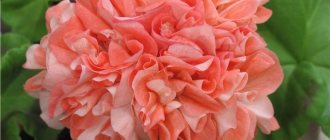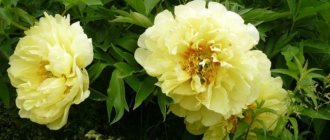Breeders from all over the world are constantly searching for new species, varieties and groups of roses that can not only captivate the eye with their beauty, but are also resistant to severe cold and frost in central Russia. The perfect combination in this area was scrub roses. Despite the fact that they need to be covered for the winter, they tolerate cold well and are resistant to frost.
In the article we will look at: scrub roses - what they are, what types they have, how to grow them and how to care for this unique type of rose.
What is rose scrub
In English, this group of roses is pronounced "shrub", which means "shrub". All roses that are included in this group are shrubs. They have the following properties:
- A wide variety of flowers , ranging from ordinary tea hybrids to the floribunda group. As for the color of the “garden queens,” it also has a wide variety.
- Lush abundant flowering. Absolutely all varieties of this group begin flowering in early summer and end in autumn. Most varieties bloom repeatedly, but there are varieties that bloom once (for example, Fritz Nobis).
- Aroma. Almost all varieties have an expressive, pleasant aroma.
- Size. Roses in this category are distinguished by the height and strength of their branches and stems (some varieties can grow up to two meters in length).
- Resistance to frost and harmful insects. Scrubs easily tolerate cold and frost, needing only a little protection during cold weather, which cannot be said about many other groups of roses.
- Unpretentiousness. If you look at the description of caring for many varieties of scrub roses, you can come to the conclusion that even novice gardeners can cope with growing and caring for them.
- Possibility of combination with other groups of roses. Scrubs are suitable not only for single planting, but also for planting in groups consisting of three to five bushes.
Although scrub roses are an ideal solution for gardeners living in the colder climate of Russia and for just beginning gardeners, they still have a drawback - the need to cover the bush for the winter and regular pruning. So, rose scrub - what it is, you can see in the photo.
Planting process. Where?
Where to start planting rose scrubs? Planting these plants will primarily depend on which variety you choose.
If these are small, strong shrubs, then they can be planted in a well-lit, sunny place. If these are spreading or semi-climbing plants, then you should think about a support in the form of a wooden or metal pole. Seedlings of these types of roses are planted at a distance of one to two meters from each other.
Places reserved for roses should be protected from northern winds and unpleasant drafts, and the ground should not be overly wet or swampy. Rose scrubs do not like wet soil and sharp wind currents.
Types and varieties
Scrub roses have received recognition from many amateur gardeners for their ease of care, frost resistance and at the same time excellent decorative qualities. For this reason, breeders are developing new, even more advanced species. Breeder David Austin received the following varieties:
- Desdemona;
- Ancent Mariner;
- Poets Life;
- Tranquility.
We will tell you more about each David Austin variety, as well as other breeding species below.
"Desdemona"
It is distinguished by peach-colored buds, which, when the flower blooms, acquire a white color with light pinkish tints. The flower is fragrant with the aroma of myrrh and has the ability to retain its bud shape even after heavy rain or strong wind.
The Ancient Mariner
This rose variety has double flowers of fairly large size, bright pink color, which equally cover the entire bush. A distinctive feature of the rose is its golden-colored stamens, as well as continuous flowering until the onset of cold weather.
"The Poets Wife"
The bush of this variety has a spherical shape and bright yellow flowers that are not prone to fading. At the very beginning of flowering, a persistent lemon aroma emanates from the bud, but towards the end of flowering the aroma acquires sweetish shades.
Tranquility
The bush of this rose variety has a rounded shape and is decorated with snow-white flowers that exude an apple aroma. It has high decorative qualities, which makes the variety popular for landscaping squares and park areas.
Above were the latest varieties bred by breeder David Austin. Next, we will describe the plant varieties that are most often found among experienced gardeners.
"Bonanza"
It is a long-flowering shrub, the flower petals of which have different shades: the inner part of the bud has a bright orange tint, and the outer part is pink. When the bud fully opens, in its core you can see the stamens, which have a golden color. A distinctive feature of “Bonanza” is its self-cleaning, which is manifested in the fact that the plant independently controls the number of buds and leaf cover, which makes it not require pruning.
"Belvedere"
It bears large flowers of a delicate peach color. This variety looks great in one composition with several rose bushes, i.e. in a group planting. The plant exudes a slightly tart aroma that can persist throughout the flowering period. If the shrub is provided with the necessary favorable conditions, the plant can grow up to 1.2 m in height. The rose is characterized by continuous flowering, however, the greatest amount of formation and blooming of buds occurs in the first wave, followed by a number of weaker cycles. As a disadvantage of the variety, one can highlight its strong susceptibility to various diseases, such as powdery mildew.
"Anny Duperey"
This shrub, reaching a height of one meter, has bright lemon-colored flowers that exude a light citrus aroma. It has the ability to withstand severe frosts (temperatures up to -23 degrees), as well as resistance to some diseases (black spot and powdery mildew) . Among the disadvantages of this variety is poor resistance to rain, during which the buds cannot open completely or do not open at all.
"Schneewitchen"
It is one of the earliest varieties of scrubs bred (obtained in 1985). The bush can grow up to one and a half meters in height and has good branching. The plant has small light green buds that turn into white semi-double flowers, reaching 6-7 cm in diameter. Flowering is abundant and occurs continuously throughout the growing season. A distinctive feature of the variety is its fairly strong resistance to pests and diseases - this makes the plant even more popular among beginners in gardening and floriculture.
Abraham Darby
This is a strong shrub with a rounded shape, reaching a height of one and a half meters. The buds of the plant, which have a classic shape, turn into densely double flowers of a soft pink or apricot hue. The flower has smooth shiny leaves. The rose blooms quite early and is capable of continuing continuous flowering until cold weather. It is resistant to diseases and easy to care for. The only drawback is the drooping of the flowers, due to their large size (diameter approximately 14 cm) and heavy weight. The variety is able to withstand frosty temperatures down to -29 degrees, but is poorly resistant to heavy rains, during which the buds do not open.
"Countess Diana"
The rose takes its name in honor of Countess Diana Bernadotte, the famous milliner and trendsetter of modern hat fashion. The flowers of this variety are fragrant with a mixture of floral and fruity aromas, with a hint of citrus scent. The flowers are densely double, have a purple-violet color, the buds are large - about 10 cm in diameter. It has long and abundant flowering. The height of Diana's rose reaches one meter. It is characterized by high resistance to frost and diseases.
"Rococo"
It is a shrub that can grow up to 1.5 meters in length. It is decorated with large (about 10 cm in diameter) flowers with an apricot tint. The flowers are collected in small clusters, have unusual double wavy petals, and are able to withstand exposure to strong winds or rain. During the entire flowering period, the buds are subject to fading, so at the final stage of flowering they take on a pearl-cream hue. The rose has a fairly high resistance to diseases such as black spot and powdery mildew.
"Artemis"
This variety of rose has the ability to withstand frosts down to -23 degrees and is quite demanding in terms of care. The inflorescences look like umbrellas, consist of 5-10 creamy-white flowers, 5-8 cm in size. They are distinguished by almost continuous flowering and a rich anise aroma. The shrub needs good lighting, regular fertilizing and a drainage system. The variety looks great both when planted alone and in composition with other flowers.
"Blanc Meillandecor"
This is a low-growing variety and belongs to the ground cover group. The height of the bush varies from 30 to 50 cm, but the diameter of the flower is 10-15 cm. Each bud has about 70-80 snow-white petals. The flowering period begins in the first half of June and continues until the end of October. A distinctive property of this variety is its ability to withstand frosts down to -40 degrees. The rose is also highly resistant to fungal diseases.
"Sapphire"
This variety reaches a height of 100-130 cm. The flowers of the Sapphire rose are double, 6-8 cm in diameter, and have a light lilac-blue color. The petals are slightly transparent. The buds exude a pleasant, soft aroma. Repeated flowering. The plant may be susceptible to a disease such as powdery mildew, however, in the event of prolonged drought.
Classic
Other types of scrubs include such classic varieties as Romance, Fluorescent, Magnet Shrub, La Villa Cotta, Belvedere and others.
Romance is a delightful shrub one and a half meters long, with bright pink flowers and a pleasant rich aroma. The plant is incredibly hardy to heat, frost and bad weather.
Fluorescence is marked by bright red, purplish inflorescences, without any sign of aroma or fragrance.
Magnet Shrub, on the contrary, is characterized by a delicate pink color and a pleasant rich aroma. The petal buds are wavy and smooth.
La Villa Cotta is a charming variety with unusual colors. The inside of the petals has a burning copper color, and the outside is soft pink. This contrast is set off by green, glossy leaves and stems. The aroma of roses is delicate, the bush itself has an erect position and is stable against various diseases, frost and heat. Nevertheless, it is quite difficult to take root in a new place.
Belvedere is distinguished by very large peach-colored flowers and a pleasant tart aroma, but is susceptible to many pests and diseases.
Flammentanza is a climbing hybrid with huge double flowers of a crimson color. It is distinguished by early, repeated and abundant flowering.
Morden Centennial also impresses with large double buds up to ten centimeters in diameter, continuous flowering and pink-raspberry color.
As you can see, all scrub roses (photos of which do not convey even a hundredth part of their beauty) delight and captivate with their charm and grace.
What is the secret of growing them?
Features of planting in the ground
It is better to buy grafted seedlings in the autumn. After purchasing, the roots must be wrapped in moss or peat and wrapped in cellophane, storing the seedlings in a cool place until spring. Alternatively, they can be buried in a box of soil. To grow shrubs, you must follow some rules.
- Correct landing place. Such a site is a well-lit area, not blown by winds. The southern part of the garden area is ideal. It should be planted on loamy soil with neutral characteristics. Organic fertilizers must be added to the soil. Groundwater should lie at an average depth.
- Soil preparation. The soil must be thoroughly cleaned of debris, weeds, and stones. A couple of weeks before planting seedlings, you need to dig up the soil. And the day before planting, you should dig holes. Add one kilogram of rotted mullein and rotted compost to each hole.
- Disembarkation time. This factor is influenced by the different climatic conditions in which the rose is going to be planted. For example, in the southern zones, scrubs are planted in the first half of autumn. Thus, they will have time to take root before the onset of cold weather. In temperate climate zones, roses are usually planted in the spring.
- Landing algorithm. The seedling must be placed in a vase with water so that its root and stem are immersed 5 cm in water. Leave the seedling in the vase for 10-20 hours.
- Fertilizers must be applied to the intended planting site.
- Then dig a hole 60 cm deep.
- After a while, soil should be poured into the planting hole in a heap, and then warm water, at a temperature of approximately 16-21 degrees, should be poured into it, along with a humate solution. Then seedlings are planted there, straightening their root system.
- You should manually fill the young plant and shake the bush at short intervals. The soil should be compacted.
- Finally, the bush is darkened with spruce branches for a week.
Note! If you plant scrub roses in groups, do not forget to maintain a distance of 0.5-2 meters between them. It all depends on the volume of the bush.
How to grow scrubs on your windowsill?
There is nothing difficult about growing roses on your windowsill. To do this, you should follow a few simple rules:
- The location is always on the south side. Shrubs love light, so in winter, when the days become especially short, we recommend illuminating them with fluorescent lamps.
- The optimal temperature is 15-20 degrees plus. If the plants are in the sun, they need to be sprayed with water 2-3 times a day. For watering, simply pour settled water into the pan. You can also water the plants with melt water. Freeze the water in the refrigerator and let it thaw.
- Seedlings purchased in a store or market are replanted only after a week, even if this variety is a Belvedere rose. This will allow the bushes to get used to the temperature and humidity of your apartment.
- The best option for a pot is a clay one. If you don’t have one at hand, take a plastic one and make about 15-20 holes in it with a drill or awl. The drainage is made of pebbles and gravel, up to 4 cm thick. Form a drainage, fill in the soil and straighten the roots. After this, fill in the remaining soil, compact it and water it, and then leave it in the shade for one day.
We tried to tell you the most important information about scrubs. Now you know what kind of roses these are, what varieties and varieties there are, how to care for them and how to fertilize them. We hope that now these wonderful shrubs will become a worthy decoration of your site. It’s not for nothing that they say that the rose is the real queen of flowers!
Rose care
Despite the fact that scrubs are considered a fairly unpretentious plant, the shrub must be pruned, watered, fertilized, covered for the winter, etc. in a timely manner.
- Watering. This group of roses prefers to grow in moist soil, but it does not tolerate stagnant water. Watering should be done once every 7 days. It is important that moisture does not fall on the foliage, otherwise they may be affected by fungal diseases. If watered incorrectly, the rose sprouts will be low and there will be a small number of flowers. After watering is completed, the soil must be loosened and the bushes hilled.
- Fertilizer. To prevent excessive evaporation of moisture, the soil can be mulched with compost or peat. In the spring, when the first shoots appear, nitrogen is added. In summer, potassium and phosphorus are added for active flowering and growth.
- Trimming. It is obligatory in spring: it is worth cutting off already dry branches, as well as some of the shoots for more intensive growth. It is necessary to cut the stems with pruning shears at an angle of 45 degrees. If a diseased shoot is discovered, it should be removed down to the healthy part. In the summer, you need to remove faded buds or part of them. This is done so that the next flowers will be larger.
Planting process: digging the ground
Planting in open ground is a responsible and important task for which you should prepare in advance.
Two weeks before planting, the area allocated for roses should be enriched with fertilizer (compost, peat, humus, ash) and the fertilized soil should be thoroughly dug up.
The next step is to dig a square hole (50 by 50 cm). The depth of the ditch should be sixty centimeters. The size of the rhizome should also be taken into account here. If the indicators are higher, then the hole should be larger.
And then the fun begins. The hole is filled with excavated soil, filling the void by one third, and half a bucket of water is poured there along with special fertilizer for roses.
After the water is absorbed, the plant itself is planted, placing it in the middle, directly vertical to the ground line.
You should fill the hole with your hands, slightly compacting the place so that you get a depression of five to six centimeters.
After this, it is important to mulch the bush and compact the soil around it.
So, the first thing is done - our scrub rose is planted. What to do next?
Use in landscape design
Scrub roses are planted in the center of the flower bed, against the background of the lawn or in another prominent place. They look spectacular along borders or in a group of five long-flowering bushes. Flowering scrubs are also used to form balls called fountain roses. Separately planted, rather large bushes can be planted on the sides with low-growing and less spreading varieties.
Ground cover scrubs are often planted next to rocks or on rocky slopes. They are used for planting in a wide variety of places: directly in the garden, on balconies, verandas. Often they are formed into trunks in the form of cascades that hang from the trunk or create “pink carpets”. Thus, scrubs will help to green the garden plot both vertically and horizontally.
Similar articles:
Rosemary: description of the plant with photos, popular types...
Features of planting and caring for gray fescue,…
What are peas? Description, types and varieties, features...
In garden decor
Varieties of scrub roses can play a different role in the horizontal or vertical decoration of a garden or some recreation area. It all depends on the height, width and growth characteristics of an individual representative.
They can be used to add color to walls, obelisks, trellises or other supports, as they can serve as climbing species.
The scrubs form a fascinating hedge or fence. They will fill the garden with strong aromas, rich in pollen and colorful fruits in the fall, containing a lot of vitamin C and providing food for birds. With the help of scrub bushes, you can realize any ideas, create a play of tones, contrasting spots against a solid background and a rainbow range of colors.
As a subgroup of scrubs, groundcover seedlings will cover the ground with a thick carpet, abundant inflorescences, filling all the bare spaces of the site. Varieties of semi-climbing roses are well suited for tapeworms or single plantings, especially if it is a good, extensive bush with an excellent habit. A scrub can be used to decorate a flower bed, lawn, rocky area, or slope. They can serve as a single variety or a mixed group. Varieties of this species are also suitable for container culture, on a balcony, terrace, since they form dense, dense layers of bushes. Rose scrubs fit well into any composition, depending on the type of landscape and growing conditions.
Rose A shropshire lad
English roses for the flower garden are chosen, first of all, by refined, romantic natures, not without love for the ancient past.
A representative of this group of varietal plants, E Shropshire Lad, will definitely become a favorite of such individuals, because it has a magnificent color and attractive flower shape, and is also a hardy crop. All the details about this beauty are in this article.
History of origin
An amazing variety appeared more than 20 years ago, in 1997. It was bred by the famous British breeder David Austin, using the Heritage variety as a basis.
Our heroine was named after the poem cycle of the same name and the poem "A Shropshire Lad", written at the end of the 19th century by the English poet Alfred Edward Houseman.
The flower is the winner of the Modern Shrub Rose award, which was awarded to it as part of the Fair Friends of the Rose Show. The registered name of the variety is AUSled.
Description of appearance and features
The variety belongs to the group of climbing English roses. This is a vigorous, tall (from 1.5 to 1.8 meters) bush with arched drooping shoots that can be easily planted on any support.
But even without it, it is quite possible to cultivate the plant, because in this case the perennial will have a rather neat appearance. The shoots of the burgundy-colored crop are equipped with sparse thorns and covered with glossy, rich green foliage.
It contrasts with large, up to 12 cm in diameter, incredibly delicate pink cupped flowers. It must be said that in warm weather, the inflorescences of the proud British beauty E Shropshire Ice contain more apricot notes.
In the full bloom phase, the outer petals of the buds bend down and show rich pink tones. The edges of the petals have a pale cream color.
The flowers of this variety are very fragrant. Their smell combines the fragrance of tea hybrids and juicy fruits. The flowering of the crop occurs in two powerful waves and lasts from the end of June until the first autumn frosts. The flowers remain on the bush for quite a long time and keep their shape for a long time. They are collected in groups of 3-5 pieces each and are concentrated mainly in the upper part of the shoots.
Rose is characterized by a high growth rate and excellent immunity to fungal diseases, especially powdery mildew and black spot. The shrub does not have very good drought resistance, and its inflorescences have average resistance to rain. In the sun, the petals of amazing flowers do not bake or fade. The plant is winter-hardy, withstands frosts down to -29ºС.
Growing and care
Despite the rose’s loyal attitude to adverse weather conditions, it is better not to plant A shropshire lad in a place where it will be exposed to direct rays of the sun all day.
If you neglect this recommendation, the flower petals of this delicate beauty will quickly fall off. The best option is to place the shrub in open partial shade.
It should not be placed in lowlands due to stagnation of moisture in such an area after heavy rains (to avoid rotting of the roots).
For planting E Shropshire Ice, it is preferable to use fertile, loose soil with a neutral reaction. To increase the nutritional level of the soil, it is mixed with compost, humus and vermicompost, as well as a small amount of sand to increase the lightness of the substrate.
The noble plant must be planted in a hole at least half a meter deep and the same width so that the buds are 3 cm below the soil level. Do not forget to lay an impressive layer of drainage material at the bottom of the hole. It is advisable to maintain a distance of 45-50 cm between plants.
Denser planting will only allow the crop to grow faster over time. The procedure for planting roses is carried out in the spring.
The British variety must be watered as the soil under the flower dries, regularly fertilized, and pruned. The decorative perennial will also need loosening the soil and weeding. The crop should only be watered with warm, soft water, which is poured under the bush in the amount of 2-3 buckets.
In hot weather, do this up to three times a week. Feeding of the bush is carried out standard: with nitrogen fertilizer in the spring; mineral, including those containing trace elements - during the bud formation phase, during the flowering period and a couple of weeks after the rose has faded.
After loosening the soil, it would be a good idea to mulch the soil under the bush in the tree trunk area. Choose humus or dry grass for this. Pruning of the varietal crop is needed in early spring. It involves removing damaged shoots, dry stems and oversized branches from the bush.
The crown is also thinned in order to form it. In summer, faded buds must be removed. In addition, shoots are shortened by a third of their main length. This procedure helps to achieve the appearance of flowers along the entire length of the stems.
When growing A shropshire lad in regions with harsh climates, it is better to cover the plant. A polycarbonate sheet is used as insulation. The perennial is first covered with crushed pine bark at the base.
Use Cases
Variety E Shropshire led is used in landscape design for planting in borders, mixborders, and round flower beds. Rose bushes are planted on the site to decorate a hedge, to decorate a gazebo, a low pergola, an arch, or the wall of a house. The plant is also suitable for single plantings against the backdrop of a bright grass lawn or the needles of evergreens in the background.
How to plant
Before planting, the plant should be placed in a container of water for 20 hours. This is done so that the water level is low and the stem is only five centimeters in the water. The soil should be fertilized before planting roses. After this, you can dig a hole in the area with a depth of up to 60 centimeters.
You need to pour some soil into this hole, pour warm water and humate solution over the soil. After this, the seedling is lowered into the hole and its roots are straightened. Then the plant is sprinkled with soil and the soil is lightly compacted. A maximum of six centimeters is added to the grafting site.
The shrub planting site should be hilled up and covered with spruce paws for seven days. If you decide to plant a plant in a group, then the interval between them should be at least 50 centimeters. The gardener must familiarize himself with information about the selected variety in advance and understand its volume. It is best to cover the lower part of tall bushes by planting dwarf shrubs nearby.
Watering mode
Shrubs have a lot of leaves and flowers that need to be nourished. The plant absorbs nutrients and moisture from the soil, so it is important for the roots to develop. In order for nutrients to be better absorbed, the plant needs rare but abundant watering. Usually one bush requires up to two or three buckets of water. It is enough to water the bush once every seven days, but less often. The watering schedule depends on weather conditions. In hot weather, roses are watered more often. You should not refuse to water the plant during rains, because rainwater entering the soil does not completely wet the roots.
The shrub should not be watered or watered frequently, since the roots develop quickly at the surface, and others will not have enough moisture. The main roots of the rose will begin to die, and the bush will simply dry out from a lack of nutrients.
Watering is carried out in the evening or morning. The leaves and soil should dry out before nightfall to prevent a fungal infection from developing. When watering the leaves and bush during the day, the plant may get burned.
Rainwater is suitable for irrigation, which is best heated in the sun. Tap water should not be used. If there is no other way out, then it is recommended to settle such water.
At the end of summer, the amount of watering is reduced as the shrub prepares for winter. It does not need to develop, and growing shoots and blooming flowers will further weaken the rose. During autumn rains, watering is stopped completely. The plant receives enough rainfall during this period.
Plant nutrition
This group of plants, like ordinary roses, should be fertilized with fertilizers containing phosphorus, potassium, and nitrogen.
In the spring, rose scrubs should be fertilized with nitrogen compounds, which improve the growth of green mass and shoots. After the buds have formed, you need to reduce the amount of nitrogen fertilizer. At this time, it is better to feed the bushes with fertilizer containing phosphorus and potassium. This will improve flowering if the root system of the shrub is quite developed.
At the end of summer, fertilizing with nitrogen should be abandoned. Fertilizer is produced only with compounds containing phosphorus and potassium.
You can replace the compounds with organic compounds and minerals. It is difficult for inexperienced gardeners to choose their concentration. Trying to enrich the soil with a plant just by eye, you can accidentally salt the substrate, destroy the beneficial microflora in the soil, and the absorption of nutrients worsens. To prevent this from happening, you should alternate such feedings.
Trimming process
Pruning gives the bush a decorative appearance and makes it healthier. In the spring, it is recommended to carry out sanitary pruning of diseased, dry, infected branches.
The pruning depends on what the gardener plans to do next with the plant (wrapping around the support, composition, forming a bush).
In the fall, after flowering stops and the leaves on the bush begin to fall, pruning must be done. From spring to autumn, the plant accumulates nutrients to make it easier to endure the harsh winter. Pruning is done as preparation for covering roses for the winter. It is best to perform this procedure after frost, for example, at minus five degrees.
To form a bush, pruning is done in the spring. The gardener should cut off damaged shoots and leave only three to five main branches. Shoots should not be cut to more than one third of the stem length. If you cut more, the bush will bloom poorly, because not all the buds wake up in the summer. The upper buds contribute to the development of new side shoots, so the bush blooms more abundantly.
This category of roses includes many varieties of the plant, so it is impossible to definitively recommend a universal type of pruning. For spreading bushes, you should leave the natural shape of the bush and simply trim the branches to 1/3 of the total length. In bushes with arched stems, it is not recommended to cut branches by more than 1/5. For upright plants, cutting the stems into ½ shoots is best.
Currently reading:
- Exquisite juncus (rumen) spiral-shaped in the interior
- Graceful, easy-to-care for coniferous bushes in garden plots
- Planting to decorate the site with three types of coniferous trees
- Confidentiality
Share the news on social networks
About the author: Victoria Semyonovna Nakhodkina
Leading researcher at the laboratory of vegetable and berry crops, Yakut Scientific Research Institute of Agriculture, Siberian Branch of the Russian Academy of Agricultural Sciences, Republic of Sakha (Yakutia).
Pests and diseases
Good gardening practices, such as removing dead leaves and stems, will help reduce pests. If problems arise, horticultural oil and insecticidal soap can help control insects and fungi.
Black spots
The leaves of the plant have black spots that eventually turn yellow. This is often caused by water splashing on the leaves, especially during rainy weather. The leaves may need a protective coating, which should be applied in the summer before leaf spots appear. In the fall, thoroughly clear away debris and trim off any diseased stems.
Dates for planting roses in Russia
Planting of climbing roses in the Moscow region and central Russia is carried out in late April - early May, at a soil temperature of 10-12 degrees Celsius, but before the buds begin to bloom. According to observations, climbing roses planted in spring have a slight lag in growth compared to autumn seedlings by an average of 14 days.
Planting climbing roses in summer is recommended for self-rooted plants (grown from cuttings, layering or propagated by dividing the bush) in containers with a closed root system. Beginning gardeners are advised to purchase them, however, it should be borne in mind that in the first year these plants are weaker than grafted specimens, which means they are more demanding in terms of care, especially in terms of shelter for the winter.
Planting climbing roses in the south is carried out in the fall, until mid-October. After just 2 weeks, the plant will be able to form new root shoots. In winter, the young rhizome will harden, and with the onset of spring it will develop simultaneously with the above-ground part and form a strong bush.
Scrubs in landscape design
Although we have already briefly touched on this topic, let's dwell on it in a little more detail.
As mentioned above, roses of this class can be combined with other varieties and subspecies, as well as with flowers of bright contrasting color.
How can you use scrubs to decorate your own home or garden? Of course, this depends on the appearance of the plant.
Roses can be used to create hedges and borders that will highlight the lush greenery of the lawn, emphasize the stylishness of the garden path, and highlight the beauty and unusualness of other plantings.
Scrubs can be combined with evergreen shrubs and trees. They can be used to decorate arches, gazebos, fences and even the external walls of domestic or technical structures. As you can see, it all depends on your imagination and preferences.
A photo of landscape design using roses - as an example - is presented below.
Planting scrub seedlings
Growing scrubs is a very simple task for beginners and experienced gardeners. Roses of this class are absolutely unpretentious and can be grown both in gardens and flower beds, in group plantings or in one specimen. Scrubs look very impressive on arches, as well as on grilles.
Very often, such roses are planted on lawns, in the center of a flower garden or flower bed, or in any other prominent place. If you are going to form a decorative group of roses, you should maintain a distance between the roses - from one and a half meters to two. The distance is determined by the variety of shrub, since the bushes can be less or more spreading.
Groups and borders of scrub roses look especially impressive. In such plantings it is better to use at least five bushes with a long flowering period. From scrubs you can make real bush balls - fountain roses. If you prefer single planting, select varieties with high decorative qualities and exclusive flowering, bright and rich aroma. Such scrub roses can be planted near gazebos, patios, swings and other recreation areas in the country. Several small, low-growing scrubs can be planted near large bushes.
On rocky and rocky terrain, spreading ground cover scrubs can be planted. They are also suitable for planting on verandas, in the garden, on loggias and balconies. You can make a standard of them in the form of a beautiful cascade or a sophisticated plant carpet in the garden, selecting varieties with long shoots and lush flowering.
There are several basic ways to plant scrub roses:
1. Hedge. If you need a hedge of plants to decorate your area, scrub roses are a great option.
2. Group. Scrub roses are often planted in groups of three or five bushes. They can be planted in a row or in the shape of a triangle. The distance between plants in this case is fifty centimeters. In this way, you can create a real park figure on the site. If planting is carried out in a row, the distance should be from one and a half meters.
3. Solitaire. It is a single planting of scrub, which is perfect for a miniature garden or flower garden. This scrub rose will become a real decoration for your flowerbed or local area. It is better to select varieties with a beautiful crown, very lush flowering and miniature bushes.
If you have already selected healthy and high-quality seedlings, you need to start planting roses. Before planting, you need to prune, leaving only a few shoots on the plant with developed and strong buds - from three to five on each shoot. But all dry and damaged shoots need to be cut into a ring. The root system also requires pruning. Long roots need to be shortened to twenty-five centimeters.
The planting pit for the scrub should be selected according to the size of the seedling and the variety. On fertile soils, holes are dug narrow and not very deep. But in unfavorable soil conditions, make the hole deep and wide, filling it halfway with a layer of drainage and fertile substrate.
Make a small hole around the planted scrub and water the bush generously. After watering, add a little more soil under the scrub. During spring planting, it is necessary to mulch or hill up the rose so that moisture is retained in the soil for a long time. The height of mulch or hilling is up to fifteen centimeters.
You can learn about the best mulching materials here.











